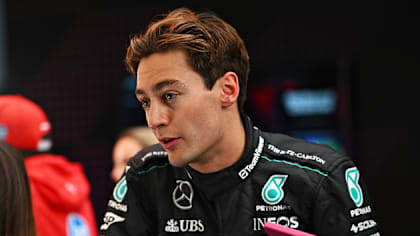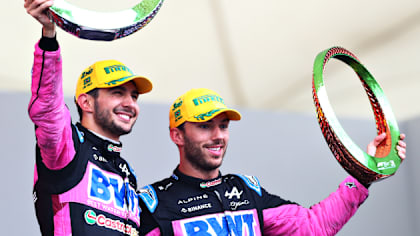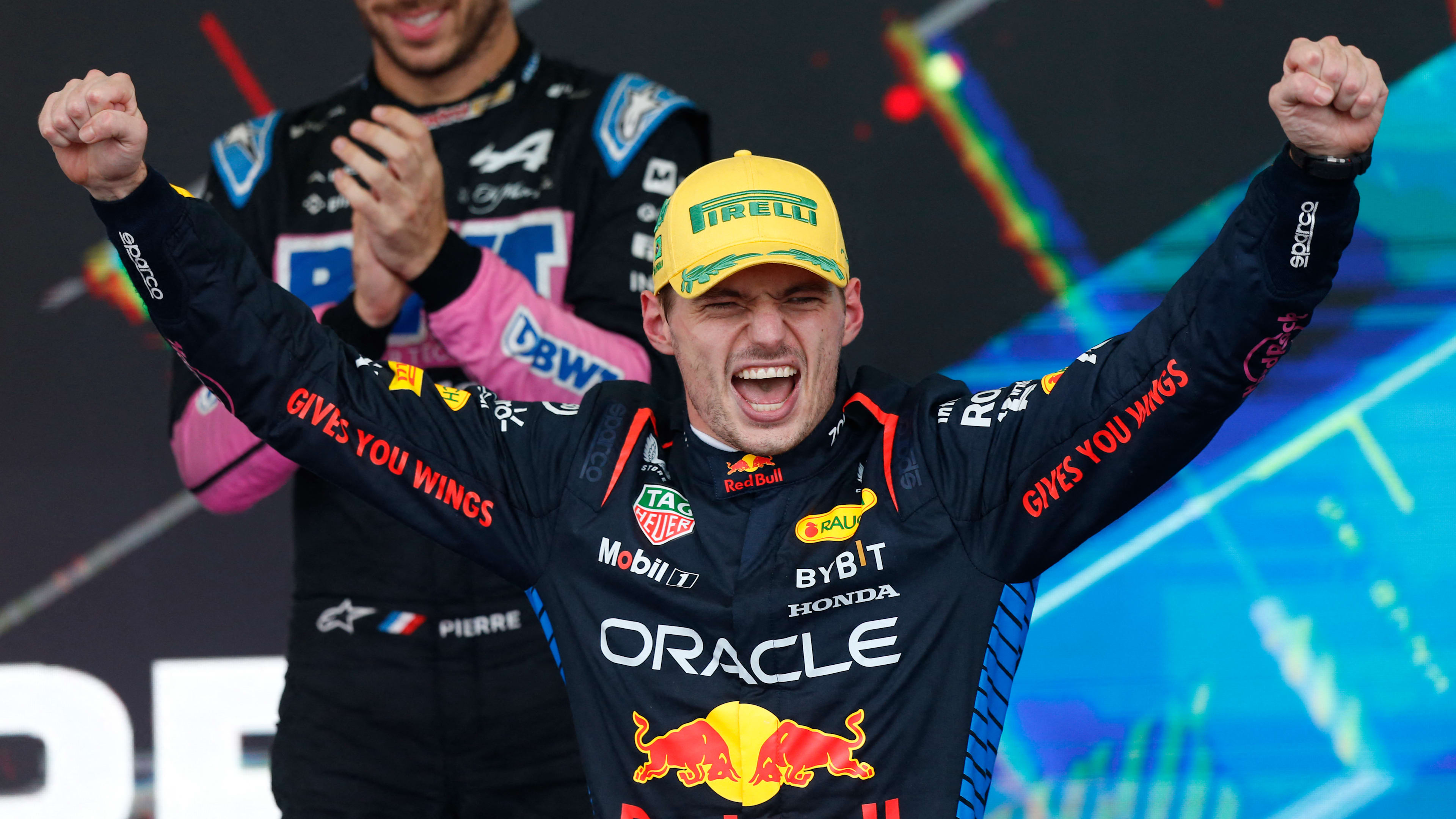Senna overcomes gearbox gremlins to ‘do his duty’, Interlagos, 1991
By 1991, Ayrton Senna had pretty much done it all in F1 terms: he was a double world champion and a 26-time Grand Prix winner, already regarded as one of the best ever. But there was one thing he hadn’t done, something he regarded as 'his duty': win on home soil. For a man as passionate about his homeland as Senna, this was a source of particular anguish, so you can imagine how he felt when, with victory in sight in the 1991 event at Interlagos, his gearbox began to fail him. In quick succession third, fourth and fifth gears went missing in action, but somehow the Brazilian maestro wrested his McLaren into sixth gear and was able to coax it to victory ahead of Riccardo Patrese’s charging Williams. That he did it with cramps and muscle spasms caused, in his own words, “partly because the harness was slightly too tight, partly through emotion” made the feat even more remarkable. The unbridled scenes that followed - an exhausted Senna, his face at once etched with great pain and great relief, being lifted from his car before struggling to find the strength to lift the winner’s trophy - remain amongst the most iconic of his career.
Schumacher bows out after heroic recovery drive, Interlagos, 2006
Ten points down on title rival Fernando Alonso with only ten points to be won, Michael Schumacher knew he needed everything to go his way to snatch the world championship away from the Spaniard at the season finale in Brazil in 2006. As it happened, luck wouldn’t be on Schumacher’s side in what was supposed to be his swansong race in F1 - but that didn’t stop him from producing one of the grittiest and most determined performances of his career. Consigned to 10th on the grid because of technical gremlins, Schumacher swiftly carved his way up to P4, only to pick up a puncture after passing Giancarlo Fisichella’s Renault which dropped him back to 19th. Ambition undimmed, Schumacher surged back up the order again, pressuring Fisichella into a mistake to take fifth before forcing his way past Kimi Raikkonen - the man who was set to replace him at Ferrari - for his eventual finishing position of fourth with a typically bold move into Turn 1. A champion’s drive, if not a championship-winning one.
Button deliver's champion's drive from lowly grid slot, 2009
Jenson Button went into the Brazilian Grand Prix weekend, the penultimate round of the 2009 championship, on the verge of clinching the world title, but a dodgy tyre choice in an inordinately long, rain-interrupted qualifying session left him 14th on the grid and with a mountain to climb - especially as Brawn team mate and title rival Rubens Barrichello was on pole. But on the Sunday there’d be no stopping Button as he delivered what in his words was “the best race I’ve driven in my career”. Up to ninth after an incident-filled first lap, the Englishman then put caution to one side to pull off a series of decisive passes, eventually pulling himself up to fifth by the flag. With Barrichello slumping to eighth after a puncture and championship outsider Sebastian Vettel only fourth, that proved enough to see him crowned a popular champion. You couldn’t say he hadn’t earned it.
Piquet wilts after epic effort, Rio de Janeiro, 1982
Driving a Formula One car has always been about finesse, but in 1982, with ground-effect designs sending cornering G-forces through the roof, it was about brute strength too. In some Grands Prix, simply making it to the flag was an achievement - and Brazil was one of those races. Held in stiflingly hot and humid conditions at Rio’s bumpy Jacarepagua circuit, Nelson Piquet gave the noisy home fans exactly what they wanted by defeating Gilles Villeneuve (who spun his Ferrari under pressure) and Williams’ Keke Rosberg from all the way down in seventh on the grid. But as the world champion took to the podium it was clear his victory had come at some cost as his legs went limp and he collapsed into the arms of those around him. A small price to pay for victory you might think, but the Brazilian’s efforts would ultimately be in vain as both he and Rosberg were latterly disqualified for having underweight cars - part of an ongoing dispute over equivalency between the turbo runners and their naturally-aspirated rivals. Still, at least Piquet lasted the course - his Brabham team mate Riccardo Patrese could only hang onto his BT49D for 34 laps before spinning off, reportedly after blacking out from exertion…
Vettel recovers from first lap spin, Interlagos, 2012
With a 13-point lead heading into the 2012 season finale, Sebastian Vettel held all the aces in his championship face-off with Fernando Alonso, but it took just four corners for the situation to be turned on its head as the German was inadvertently spun around by Williams’ Bruno Senna. For a brief moment, as he sat facing in the wrong direction, his Red Bull showing signs of substantial exhaust and floor damage, it looked like all hope was lost, but after righting himself it quickly became apparent that Vettel’s car was not mortally wounded. The comeback was on - Vettel simply had to haul his way as far back up the field as possible and hope that Alonso - running near the front - didn’t get the points swing he needed. But there was a further wrinkle: his radio had stopped working properly, so whilst he could hear his team, they couldn’t hear him - hardly ideal in changeable conditions. A slow pit stop followed, but still Vettel refused to give in, making several passes before countryman Michael Schumacher waved him by into sixth. With Alonso only second, that was good enough to make Vettel the youngest triple champion in F1 history.
Mansell ‘hangs on’ for victory on Ferrari debut, Rio de Janeiro, 1989
Ferrari’s 1989 challenger - the John Barnard-penned 640, with its revolutionary semi-automatic gearbox - had been so unreliable in testing that many, including driver Nigel Mansell, didn’t expect it to reach the flag at the season opener in Brazil. In fact Mansell was reportedly so sure it would break down that he booked himself onto an early flight home from Rio. As luck would have it, Mansell had wasted his money, for not only did he reach the flag, he did so in first place, becoming the first Ferrari driver to win on debut since Mario Andretti in 1971. However, whilst his hi-tech gearbox held together, it wasn’t all plain sailing for the moustachioed Englishman as he encountered an altogether more worrying problem towards the tail-end of the race when the locking mechanism holding his steering wheel in place loosened at the end of the straight. Unperturbed, Mansell clung on until his next stop, whereby Ferrari, to the surprise of onlookers, serviced him with four fresh Goodyears and a new steering wheel. It was an unconventional move at the time, but one that allowed him to quite literally hang on to victory. His reward? Cutting his blistered palms on the razor sharp trophy edges!
Hulkenberg takes stunning pole, 2010
Long tagged with the not-always-helpful moniker of ‘future world champion’, it took until the 18th race of Nico Hulkenberg’s debut F1 season for him to show the world his incredible potential. In a tricky wet-dry-wet-dry qualifying session where the weather really couldn’t make its mind up, Hulkenberg made the most of a levelled out playing field to beat all of the big boys to pole – Williams’ first for over five years. Not amongst the quickest runners in the first two parts of the session when intermediates were the tyre of choice, Hulkenberg confidently surged to the front as others tip-toed when he bolted on slicks in still damp conditions in Q3. His penultimate lap would have been good enough for pole, but not knowing that at the time he went round again and incredibly put more than a second between himself and Sebastian Vettel’s Red Bull, which was best of a well beaten bunch. That the German youngster fell to eighth in dry conditions in the race was by no means a major disappointment - it simply served to underline just how outstandingly he’d performed on the Saturday.




